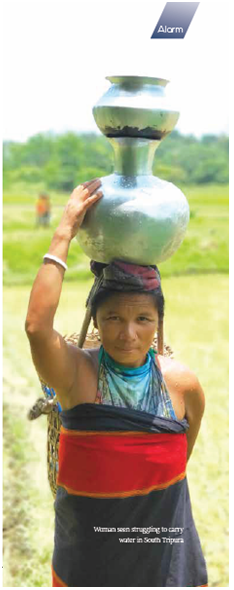A story of water woes in Tripura

Puspabati Mog, a 41 –yr old tribal housewife of Chalita Bankul village under Rupaicherri block of South Tripura has been fetching water from a stream at least twice in a day walking down three kilometre distance each time, as availability of potable surface water is in the entire stretch of Devtamura hill range. It’s not the case of usual non-availability of water infrastructure in Indian village but it was due to geo-hydrological formation. According to government record, a part of Udaipur, Amarpur, Sabroom and Belonia fall under water scared map of Tripura, despite having sufficient rainfall. The Central Ground Water Board report indicated the main source of ground water recharge in South Tripura is precipitation. Other sources of ground water recharge in the area are return flow from irrigation and seepage from ponds / tanks. Recharge from rainfall in the area accounts for 90% of the total annual recharge. The net ground water available in the district was 587.5 million cubic metres. The report claimed Bagafa block (Near Udaipur) is having the highest available ground water while Karbook block (Amarpur) is having the lowest. Puspabati is one among the female folk of the village who is experiencing the water scarcity for last 10 years.
At the beginning of her life they experienced the atrocities of armed militants who had often stormed the villages and forced them to cook food for them. But there was not much problem of potable water and vegetables. They had never been to market for buying edible items including fish. Root, shoot, bark, fruit, leaf, flowers, birds, mammals and insects wild in the villages had not only provided them food security but also supplement their medical needs without going to hospitals. The demand of cash was not much except monthly travel to bigger markets and buying cloths and a few utensils but today everything has gone and cash becomes the main driving force to maintain minimum livelihood. Plenty of water falls down from the hills and the villagers used to collect water from nearest to their house. But today only one falls remain for the villagers to fetch water – concreted roads are build to reach the water point but distance is almost double, which most of the villagers avoid.
stormed the villages and forced them to cook food for them. But there was not much problem of potable water and vegetables. They had never been to market for buying edible items including fish. Root, shoot, bark, fruit, leaf, flowers, birds, mammals and insects wild in the villages had not only provided them food security but also supplement their medical needs without going to hospitals. The demand of cash was not much except monthly travel to bigger markets and buying cloths and a few utensils but today everything has gone and cash becomes the main driving force to maintain minimum livelihood. Plenty of water falls down from the hills and the villagers used to collect water from nearest to their house. But today only one falls remain for the villagers to fetch water – concreted roads are build to reach the water point but distance is almost double, which most of the villagers avoid.
The human activity in deep forest was very limited till 2008 and whatever little movement occurred was for Jhum (slash and burn method of shifting cultivation). However, in counter insurgency operation by the then government had adopted the plan to set up security camps in hilly interiors and increase the movement of administration in each and every corner to develop social infrastructure and expand road network. The militant abducted the civilians and kept confined into the deep forest of Tripura and released after payment of ransom. The government had targeted to wipe out those bases across the hill up to eastern border of Tripura with Bangladesh. According to state government report, between 2003 and 2008, more than 1300 different types of security camps were set up in hilly areas and more than 1700 kilometres road connectivity was established for movement. Traditionally, tribals of Tripura are dependent on forest like other parts of the country. But due to insurgency, the movement of the tribals inside forest even for their livelihood was restricted. The development activities in the deep interiors have given opportunity to the people to occupy the hill tops. The Forest Survey of India (FSI) report has also indicated, the loss of forest cover in Tripura. In 2013, report of FSI stated that out of the total area of 10,486 sqkm, coverage of forest was recorded 4750 sqkm includes only 109 sqkm dense forest.
The massive deforestation in hills and loss of massive vegetation cover has caused soil erosion and several flora of Tripura have extinct now. The alarming rate of forest loss in Tripura hills affected the agricultural productivity in hilly parts of the state and increased the use chemical fertilizer manifold.
To read the further articles please get your copy of Eastern Panorama August issue @http://www.magzter.com/IN/Hill-Publications/Eastern-Panorama/News/ or mail to contact @easternpanorama.in

